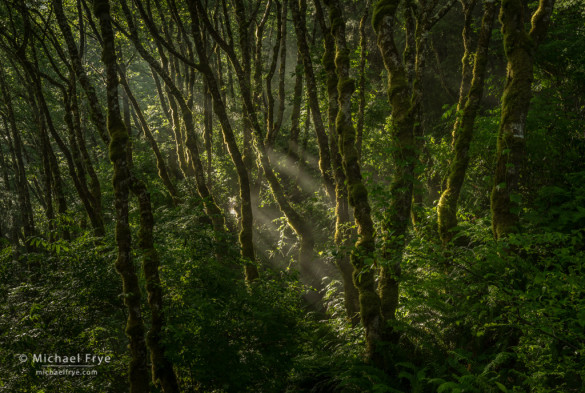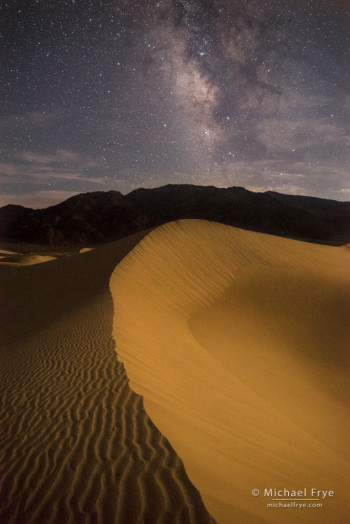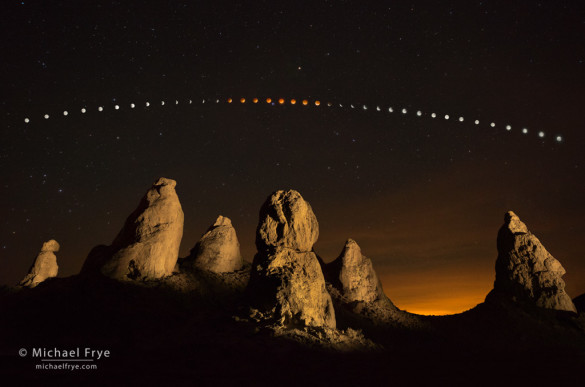by Michael Frye | Dec 30, 2014 | Announcements

Alders and sunbeams, Redwood NP. My most popular post in 2014 was a review of the Sony A7r, the camera used for this photo. The Sony sensor allowed me to capture great detail, and also lighten shadows without generating noise.
With the new year approaching, it seems like a good time to look back at my most popular posts from 2014:
Should Your Next Camera be a Sony?
I don’t talk about equipment very often, because more gear won’t make you a better photographer. But I felt compelled to test – and write about – the Sony A7r because Canon has been so slow to make improvements to their full-frame sensors, and the A7r offers a higher-resolution, low-noise body that can be used with Canon lenses. Plus it’s a mirrorless camera, and I wanted to see if an electronic viewfinder could work for serious landscape photography.
(more…)
by Michael Frye | Sep 7, 2014 | Night Photography

Moonlit sand dunes and the Milky Way, Death Valley. This is the photograph I originally envisioned from Death Valley, with dunes lit by the setting moon and the Milky Way above. (20 sec. at f/2.8, 6400 ISO)
Where do you go to escape the crowds on Labor Day weekend? How about Death Valley, where the temperature was forecast to be 112 degrees! That should keep the tourists away.
Okay, escaping the crowds wasn’t really the motivation for going to Death Valley in August. I had an idea for making a photograph with low-angle moonlight illuminating the sand dunes, and the Milky Way above. The moon had to be in the right phase: too much moonlight and the sky would become washed out, obscuring the Milky Way and most of the stars; too little and you wouldn’t see the effect of the moonlight on the dunes.
The moon also had to be far enough from the Milky Way to keep the moon itself out of the photograph, as it would be impossible to properly expose both the moon and the landscape in the same frame. The moon also needed to be close to the horizon, and off to the side (with the camera pointed at the Milky Way), as that low-angle sidelight would emphasize the form and texture of the dunes.
Not long ago I wrote about two apps for forecasting the position of the Milky Way and moon, PhotoPills and Star Walk. Consulting both of these apps I had figured out that the moon and Milky Way would be in the right position for the photograph I had in mind on the Friday and Saturday before Labor Day. And the next time the moon and Milky Way would be in a good position for this would be… next April, or even May. I decided to brave the heat rather than wait.
I had initially planned to go to Death Valley on Friday, but a thick bank of high clouds moved in – the remnants of Tropical Storm Marie. Since the skies looked clearer further south, Claudia and I kept driving and headed for the Trona Pinnacles.
(more…)
by Michael Frye | Apr 17, 2014 | Night Photography

Lunar eclipse sequence, April 14th and 15th, Trona Pinnacles, CA, USA
Monday night’s lunar eclipse didn’t seem to line up well with any of Yosemite’s features, so I started looking for other locations – preferably someplace with clear, dark skies, and an interesting foreground. Death Valley came to mind, but then I thought of the Trona Pinnacles, near Ridgecrest. I’d never been there, but it seemed like an appropriately “lunar” landscape – so much so that the pinnacles have frequently been used to represent alien landscapes in sci-fi movies, including Star Trek V and Planet of the Apes.
Claudia and I drove down there on Monday and arrived about an hour before sunset. And what a great spot! I wondered why it had taken me so long to visit this striking landscape. The pinnacles are actually ancient tufa towers, like those at Mono Lake, left high and dry by the evaporation and shrinking of Searles Lake.
(more…)











